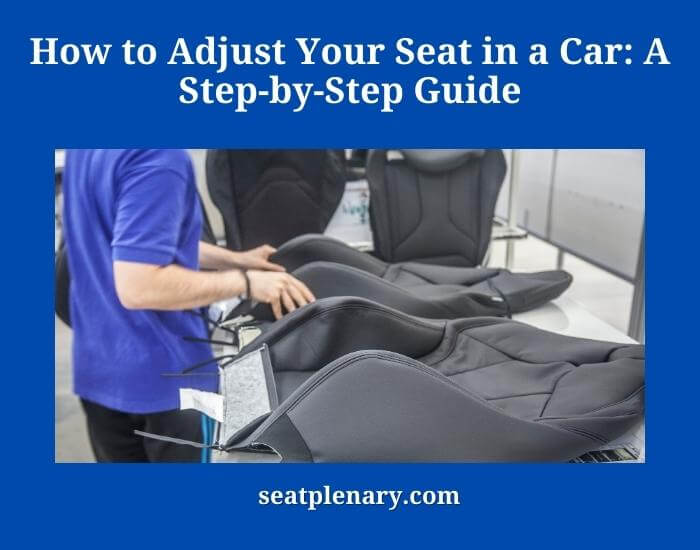When it comes to driving a car, safety should always be a top priority. One of the most important aspects of driving safely is ensuring that you are comfortable and in control behind the wheel. And one of the key factors that affect your comfort and control is the way that you adjust your seat. Proper seat adjustment can help to reduce the risk of injury in the event of a collision, prevent fatigue during long drives, and improve your overall driving experience.

Many drivers don’t take the time to adjust their seats properly before they set off on a journey. They might assume that the seat is already in the correct position, or they might simply forget to make adjustments before they start driving. This can lead to discomfort, poor posture, and an increased risk of injury.
Adjusting the Seat Height
The height of your seat is an important factor in ensuring your comfort and safety while driving. If your seat is too high, you may find yourself having to stretch to reach the pedals, causing discomfort and potentially putting you at risk of injury. On the other hand, if your seat is too low, you may have difficulty seeing the road ahead, increasing the risk of accidents.
To adjust the height of your seat, look for a lever or button on the side of the seat. Depending on the model of your car, this may be a simple lever or a more complex set of controls that allow you to adjust the height, angle, and position of the seat.
Once you’ve located the appropriate control, adjust the seat height so that you can see over the dashboard without straining your neck or back. Your hips should be level with your knees or slightly above them, and your feet should be able to reach the pedals comfortably.
It’s important to remember that your seat height will affect the position of the headrest and the angle of the backrest. You may need to make further adjustments to these features once you’ve set your seat height.
A good seat height will not only ensure your comfort but also reduce the risk of injury in the event of an accident. If your seat is too high, you may be at risk of injury from the airbag, which is designed to deploy at chest height. If your seat is too low, the airbag may not be effective in protecting you.
Adjusting the height of your seat, you can also consider using a cushion or lumbar support to improve your posture and reduce the risk of back pain. A good seat height, combined with appropriate support, will help you to maintain good posture and avoid discomfort while driving.
Adjusting the Seat Position
Adjusting the height of your seat, you’ll also need to make sure that it’s in the right position. The position of your seat affects your comfort, control, and visibility while driving.
To adjust the position of your seat, start by ensuring that you’re sitting in a comfortable position. Your back should be against the backrest, and your hips should be as far back as possible in the seat. Your legs should be bent at a slight angle, and your feet should be able to reach the pedals comfortably.
Once you’re in a comfortable position, adjust the seat position so that you can reach the pedals and steering wheel without stretching or leaning. You should be able to depress the pedals with the balls of your feet, rather than having to point your toes or lift your heel off the floor.
If you’re tall, you may need to move the seat further back to accommodate your long legs. However, be careful not to move the seat too far back, as this can reduce your visibility and control over the car.
If you’re shorter, you may need to move the seat forward to reach the pedals comfortably. In this case, you may need to adjust the backrest angle to ensure that you can still reach the steering wheel without leaning forward.
It’s important to find the right balance between comfort and control when adjusting the position of your seat. If you’re too far away from the pedals or steering wheel, you may have difficulty controlling the car. If you’re too close, you may be at risk of injury from the airbag in the event of an accident.
Once you’ve adjusted the seat height and position, you can move on to adjusting the angle of the backrest and the position of the headrest to ensure optimal comfort and safety while driving.
If you’ve ever been to a concert or sports game, you’ve probably heard the term “nosebleed seats” thrown around. Click here to know the pros and cons of choosing nosebleed seats for your next event.
Adjusting the Seat Backrest
The angle of your seat backrest is an important factor in ensuring your comfort and safety while driving. If your backrest angle is too upright, you may experience discomfort or back pain, while an angle that’s too far back can make it difficult to reach the steering wheel and pedals comfortably.

To adjust the backrest angle, look for a lever or button on the side of the seat. Depending on the model of your car, this may be a simple lever or a more complex set of controls that allow you to adjust the angle and position of the seat.
Once you’ve located the appropriate control, adjust the backrest angle so that your back is supported and your shoulders are in contact with the backrest. The ideal angle is usually between 100 and 110 degrees, which allows for proper support while also providing enough flexibility to reach the pedals and steering wheel.
If you have a long journey ahead of you, it’s a good idea to adjust the backrest angle to a slightly more reclined position to reduce the risk of fatigue. However, be careful not to recline the seat too far back, as this can reduce your visibility and control over the car.
It’s important to remember that your backrest angle will affect the position of the headrest. The headrest should be adjusted so that it’s at the same height as the top of your head, and it should be positioned as close to your head as possible without causing discomfort. This will help to prevent whiplash in the event of an accident.
Adjusting the angle of the backrest and the position of the headrest, you can also consider using a lumbar support cushion to improve your posture and reduce the risk of back pain. A good backrest angle, combined with appropriate support, will help you to maintain good posture and avoid discomfort while driving.
Adjusting the seat backrest is an important step in ensuring your comfort and safety while driving. By finding the right angle and providing proper support for your back, you’ll be able to maintain good posture and avoid discomfort while driving.
Adjusting the Headrest
The headrest in your car is an important safety feature that’s designed to prevent whiplash in the event of an accident. It’s important to adjust the headrest properly to ensure that it provides maximum protection and comfort.
To adjust the headrest, locate the button or lever on the top of the seat. In some cars, the headrest may be fixed and cannot be adjusted, but in most cars, you can adjust the height of the headrest to suit your needs.
Once you’ve located the appropriate control, adjust the headrest so that it’s at the same height as the top of your head. This will ensure that your head is properly supported in the event of an accident, and it will help to prevent whiplash.
Adjusting the height of the headrest, you should also adjust the distance between the headrest and your head. The headrest should be positioned as close to your head as possible without causing discomfort. This will help to ensure that your head is supported in the event of an accident, and it will also help to prevent fatigue and discomfort during long drives.
It’s important to remember that the headrest should not be removed or modified in any way. Doing so can compromise its effectiveness in the event of an accident and can also be dangerous if the headrest is not properly reinstalled.
Adjusting the headrest in your car is an important step in ensuring your safety and comfort while driving. By adjusting the height and distance of the headrest, you can help to prevent whiplash and reduce the risk of fatigue and discomfort during long drives.
Additional Tips for Comfortable Driving
Adjusting the seat height, position, backrest, and headrest, there are several other tips you can follow to ensure your comfort while driving:
Use a Cushion or Support
If your car seat doesn’t provide enough lumbar support, consider using a cushion or support to improve your posture and reduce the risk of back pain.
Adjust the Steering Wheel
The position of the steering wheel can also affect your comfort while driving. Adjust the height and position of the steering wheel so that it’s within easy reach and at a comfortable angle.
Take Breaks
If you’re planning a long journey, be sure to take breaks every few hours to stretch your legs, relax your muscles, and avoid fatigue.
Wear Comfortable Clothing
Wear comfortable clothing that allows for a full range of motion while driving. Tight or restrictive clothing can make it difficult to move and can cause discomfort during long drives.
Stay Hydrated
It’s important to stay hydrated while driving, especially during long journeys. Be sure to drink plenty of water or other fluids to avoid dehydration and fatigue.
Adjust the Temperature
Adjust the temperature inside your car to a comfortable level. Extreme temperatures can cause discomfort and distract you from driving safely.
Use Cruise Control
If your car has cruise control, use it to maintain a consistent speed and reduce fatigue on long drives.
In a Nutshell
Adjusting the seat in your car is an important step in ensuring your comfort and safety while driving. By adjusting the seat height, position, backrest, and headrest, you can improve your posture, reduce the risk of injury, and prevent fatigue and discomfort during long drives.
Remember to adjust the seat height so that your feet can reach the pedals comfortably and your knees are at a comfortable angle. Adjust the seat position so that you can reach the steering wheel and pedals easily, and your posture is straight and comfortable.
Adjust the backrest so that your back is fully supported and your shoulders are relaxed. And, adjust the headrest so that it’s at the same height as the top of your head and positioned as close to your head as possible without causing discomfort.
Use a cushion or support if necessary, adjust the steering wheel, take breaks, wear comfortable clothing, stay hydrated, adjust the temperature, and use cruise control if available.
Making these adjustments may seem small, but they can make a big difference in your overall driving experience. So, take a few minutes to adjust your seat before embarking on your next journey, and enjoy a safe and comfortable ride.
Relevant Resources:
